Post by cjstrapping on May 22, 2007 14:37:38 GMT -5
Here's the basic steps in cleaning a snapping turtle from start to finish. Always handle them with extreme care, avoiding the business end of the turtle. Although I've taken close to 50 pics, I've limited this "how to" to about 15, just to cover the basics, especially for all us dial up users.
Here's the basic tools required, (beer and chew optional). A good sharp knife, preferabley a 5"-6" blade, vice grips or channel locks, and a hammer. A chisel may be used as well, and will cover that towards the end.

Once you have the turtle out, give it a good rap to the head/nose area to stunt it, then clamp the vice grips on the mouth, top or bottom jaw, applying weight with your foot on it's shell.

Next, pull on the vice grips, extending the head out as far as it will go, and remove the head with your knife, cutting directly behind the base of the jaw. A few twists and rotations of the head will help remove it quickly.

You can do a few things at this stage. Lean the turtle up against a building to bleed out a bit, or stick a garden hose in the neck, clamp down tightly around the skin, with your hand, and "pump" the turtle full of water. This can aid in the speed cleaning, and also help flush some blood out. I did not do this, however, in this how to, just to keep things simple. Always discard the head immediately and away from children, as even hours after the head is removed, the muscle reaction of the jaws can still open and shut, with great force.
I like to clean the turtle on a table with a lip, so I can hold the shell towards me with some leverage. Some use protruding spike nails, and embed the shell on that. This works, but if you are saving the shells, you will have a hole in the center of it.
Start by removing the feet. There are joints that you can follow and the knife will slice thru easily when you locate them.

After all the feet are removed, start cutting around the shell, where the skin meets the shell. Where the "belly plate" meets on the sides, there is also a grisel line to follow with your knife, that will slice thru easliy.

Once your are all the way around the shell, follow the "belly plate" around with your knife, where the skin meets.
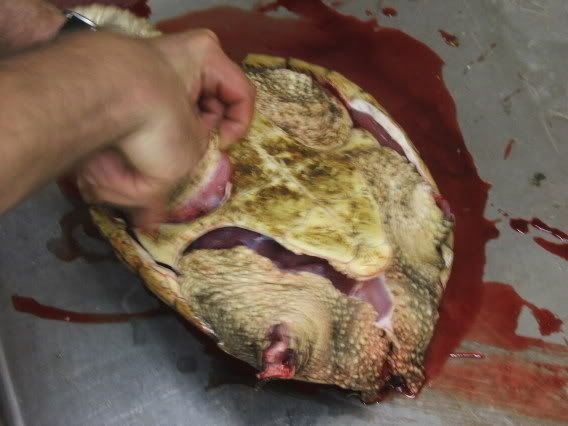
Then, like filleting a fish, remove the "belly plate" with your knife.
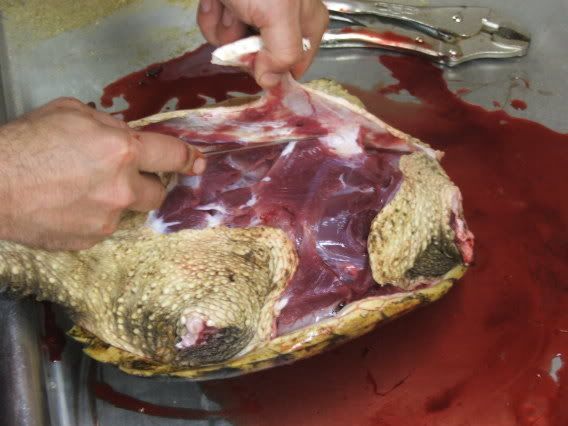
Once this is removed, you can start skinning the hide off. This is where the leverage and holes from removing the feet help. You simply skin away the hide, much like any other animal.
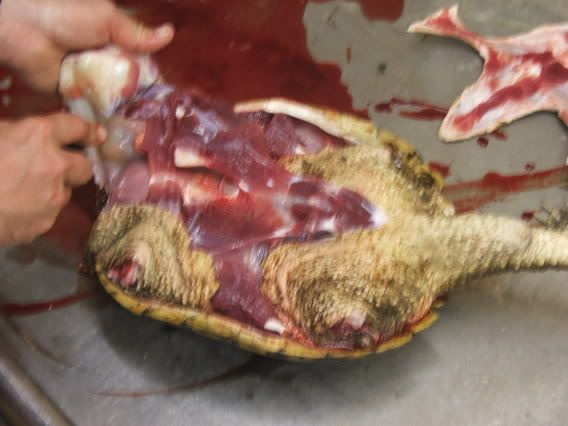
Notice the foot hole, where my finger is? This aids greatly in pulling while you skin.
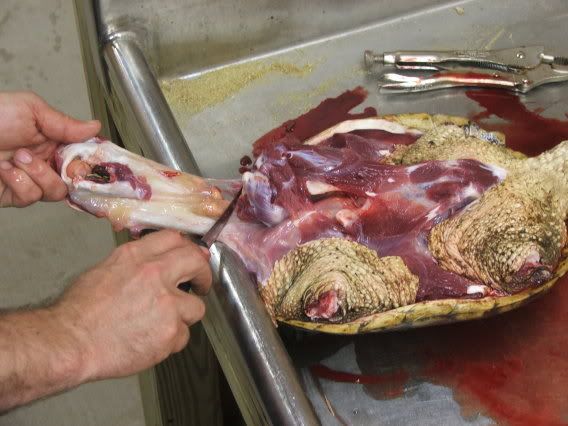
Skin all the hide off, and slit the tail down past the vent. Once you have skinned down past the vent, you can pull the tail skin off.
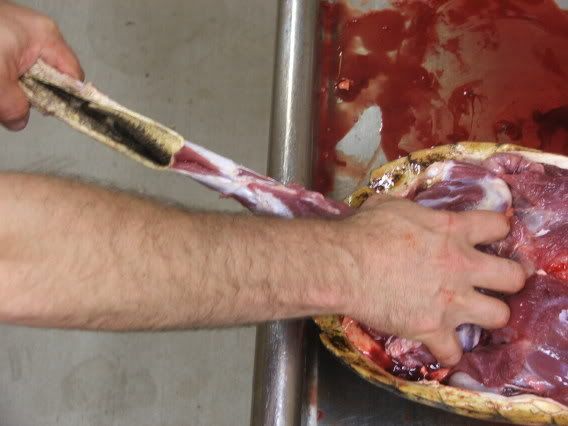
The next step is removing the sections of meat. I start with the front legs. This is really pretty simple in the fact that you cut down around each section, until you get to the joints, then twist the sections around until they pop. The knife can now be used to remove the section, by cutting at the "popped joint"
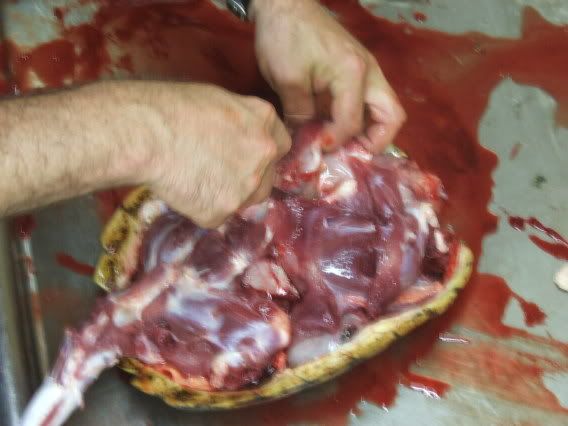

The neck is removed in the same fashion. The hind legs, before removing, should be split with the knife and hammer, gently pounding the knife thru the thick grizel in the center where the hind legs meet, until you get to the tail. They can then be removed as mentioned above. The tail should be grasped, then pushed forward, until you hear the pop, then twisted and skinned out as mentioned above.
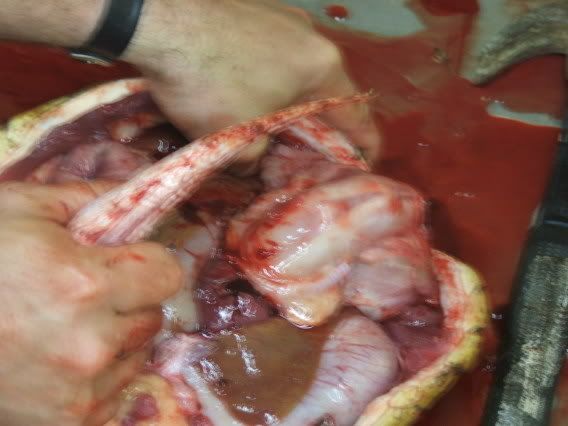
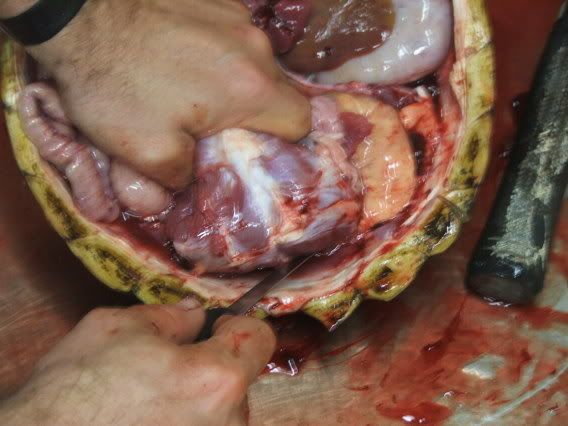
Here are the six main sections of meat removed from the turtle. The hind quarters, front quarters, neck and tail.
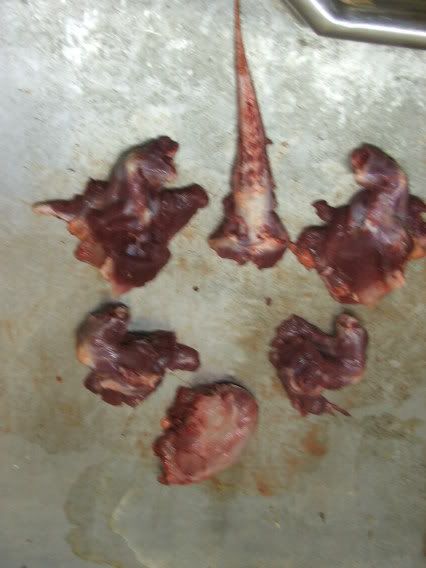
In the last pic, while I'm removing the entrails, you can see the "Backstrap" section that can be removed. It kind of resembles ribs. This is very tender meat, and makes great stock base for soup, but many feel it's not worth the extra time in removing it.
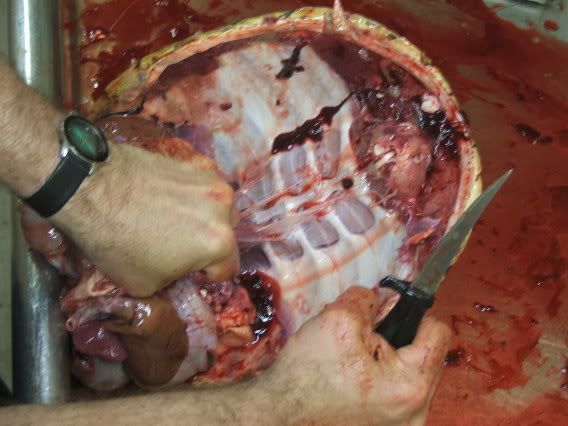
Be sure to remove all of the yellow fat from the meat, as this WILL give it a nastey taste if not removed. I had mentioned a chisel in the beginning. This, along with a hammer, can be used to remove the "backstrap" of the turtle. Some people remove it, and some don't. I did not include the in this "how to" thread, but may post another thread in the future covering that. There are, I'm sure, various knock offs to cleaning turtle, many doing things slightly different, but this is just a basic "how to" on getting you by cleaning your first turtle.
Here's the basic tools required, (beer and chew optional). A good sharp knife, preferabley a 5"-6" blade, vice grips or channel locks, and a hammer. A chisel may be used as well, and will cover that towards the end.

Once you have the turtle out, give it a good rap to the head/nose area to stunt it, then clamp the vice grips on the mouth, top or bottom jaw, applying weight with your foot on it's shell.

Next, pull on the vice grips, extending the head out as far as it will go, and remove the head with your knife, cutting directly behind the base of the jaw. A few twists and rotations of the head will help remove it quickly.

You can do a few things at this stage. Lean the turtle up against a building to bleed out a bit, or stick a garden hose in the neck, clamp down tightly around the skin, with your hand, and "pump" the turtle full of water. This can aid in the speed cleaning, and also help flush some blood out. I did not do this, however, in this how to, just to keep things simple. Always discard the head immediately and away from children, as even hours after the head is removed, the muscle reaction of the jaws can still open and shut, with great force.
I like to clean the turtle on a table with a lip, so I can hold the shell towards me with some leverage. Some use protruding spike nails, and embed the shell on that. This works, but if you are saving the shells, you will have a hole in the center of it.
Start by removing the feet. There are joints that you can follow and the knife will slice thru easily when you locate them.

After all the feet are removed, start cutting around the shell, where the skin meets the shell. Where the "belly plate" meets on the sides, there is also a grisel line to follow with your knife, that will slice thru easliy.

Once your are all the way around the shell, follow the "belly plate" around with your knife, where the skin meets.

Then, like filleting a fish, remove the "belly plate" with your knife.

Once this is removed, you can start skinning the hide off. This is where the leverage and holes from removing the feet help. You simply skin away the hide, much like any other animal.

Notice the foot hole, where my finger is? This aids greatly in pulling while you skin.

Skin all the hide off, and slit the tail down past the vent. Once you have skinned down past the vent, you can pull the tail skin off.

The next step is removing the sections of meat. I start with the front legs. This is really pretty simple in the fact that you cut down around each section, until you get to the joints, then twist the sections around until they pop. The knife can now be used to remove the section, by cutting at the "popped joint"


The neck is removed in the same fashion. The hind legs, before removing, should be split with the knife and hammer, gently pounding the knife thru the thick grizel in the center where the hind legs meet, until you get to the tail. They can then be removed as mentioned above. The tail should be grasped, then pushed forward, until you hear the pop, then twisted and skinned out as mentioned above.


Here are the six main sections of meat removed from the turtle. The hind quarters, front quarters, neck and tail.

In the last pic, while I'm removing the entrails, you can see the "Backstrap" section that can be removed. It kind of resembles ribs. This is very tender meat, and makes great stock base for soup, but many feel it's not worth the extra time in removing it.

Be sure to remove all of the yellow fat from the meat, as this WILL give it a nastey taste if not removed. I had mentioned a chisel in the beginning. This, along with a hammer, can be used to remove the "backstrap" of the turtle. Some people remove it, and some don't. I did not include the in this "how to" thread, but may post another thread in the future covering that. There are, I'm sure, various knock offs to cleaning turtle, many doing things slightly different, but this is just a basic "how to" on getting you by cleaning your first turtle.

